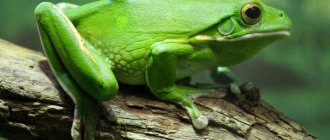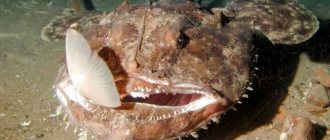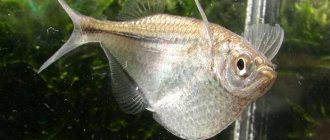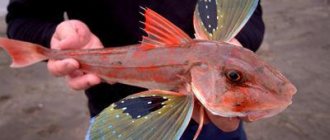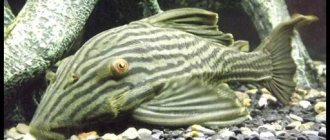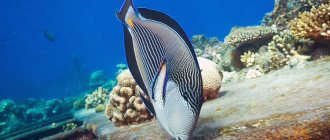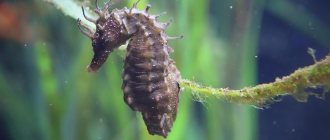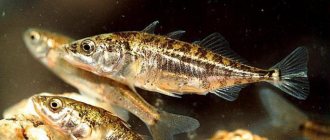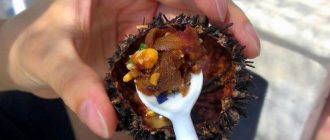Butterfly fish (lat. Pantodon buchholzi) or pantodon is a unique and fascinating fish from Africa. European aquarists first learned about the butterfly fish in 1905, and since then it has been successfully kept in aquariums. This is a predatory fish that naturally lives in stagnant and slow-flowing water. Usually they stand at the surface of the water, almost motionless, waiting for the careless victim to swim to them.
Features of representatives of the species
Pantodons are predators that inhabit bodies of water with standing water or slow currents. Usually they are located near the water surface, practically do not move, waiting for “unwary” prey.
Freshwater butterflyfish are fossil species. Scientists hypothesize that they have existed for more than 100 million years and during this time have not undergone major changes. The individuals did not adapt to the changing environment and are still alive. They have certain features:
- the body shape of the fish allows them to jump out of the water;
- the organs of vision are designed in such a way that pantodons can see what is above the surface of the water;
- The skin contains special receptors that sense the slightest vibrations in the water surface, which occur when an insect falls into a body of water.
Over millions of years of existence, these insect hunters have honed their skills, developing win-win tactics. Many aquarium collectors dream of having such an unusual pet, but keeping butterfly fish is recommended only for owners with experience, since these individuals can only live in certain conditions and require specific care.
Pantodons are suitable for a shaded, spacious rectangular tank filled with only 15-20 cm of water; they do not need vegetation. This will provide the fish with a large mirror-like surface; a lid is also necessary, since butterflies have excellent jumping ability.
Behavior
Pantodon is only interested in what floats near the surface; it will not be attracted to drowned insects or their larvae. Small aquarium fish, no more than 5 cm long, should not be placed in the aquarium with butterflies, as they will serve as food for these predators.
Compatibility with other fish
To live together in an aquarium, pantodon needs fairly large neighbors, about 7-9 cm long. It is necessary that other species of fish live in the middle or lower layers, and rise to the surface as rarely as possible. It is undesirable to introduce other predators into the aquarium, which can damage the long ray-shaped processes. This applies to Sumatran barbs, which will enthusiastically bite the fins of their neighbors. Butterflies get along well with catfish and other species that live on the bottom.
Species that are able to coexist peacefully as a butterfly:
- acanthophthalmus;
- catfish;
- angelfish;
- neon.
There are other species with similar names, but completely different in appearance and habitat. For example, in the photo there is a butterfly fish (Chaetodon), which lives in the marine environment, in coral reefs.
Another freshwater fish, the chromis butterfly (other names: apistogramma ramirezi, Venezuelan butterfly or apistorgamma butterfly) has a beautiful iridescent color, but due to its small size (4-7 cm) it can be eaten by its more aggressive neighbors.
The Bolivian butterfly is quite similar in appearance and habitat to Apistorgamma ramiresi.
Living in the natural environment
Pantodons, natives of Africa, were discovered by Peters in the 70s of the 19th century. The habitat of the fish is the western part of Africa, Nigerian, Cameroonian reservoirs, as well as Zaire; they inhabit the largest lakes. The fish belong to the genus Pantodon; if you look at the literal translation, it means “all-toothed”.
They are suitable for areas without currents, but with abundant surface vegetation. In their natural environment, fish hunt near the water surface, eating insects and other small animals, including small fish.
Benefits and harms
If we talk about the harmful influence of the burdock butterfly on the surrounding nature, then this impact can be considered insignificant. Thistle caterpillars infect weeds to a greater extent, and in small quantities.
At the same time, the freezing out of entire generations of these insects in some areas leads to a decline in butterflies as a species. This fact makes us think about taking measures to protect them. For example, in the Smolensk region of Russia, burdock has been listed in the local regional Red Book since 1997.
Appearance description
Pantodon got its name “butterfly” for its appearance - if you look at the “hunting” fish from above, because of the arranged fins it really resembles this beautiful insect:
- The wing fins are colored in shades of brown and silver, with dark dots on the main background. The fish uses them to jump out of the water to grab an insect flying over the water surface.
- Pantodons have extended pectoral fins , which allow individuals to make sharp throws over short distances.
- The large mouth is designed for feeding fish - they use it to grab prey flying over the pond and swimming in the water.
- Has special functionality swim bladder – it provides balance to the body of individuals, and is also a respiratory organ, allowing them to inhale air, which is unusual for most fish.
The size of wild individuals is 12-13 cm, aquarium inhabitants grow up to 8-10 cm. Pantodons live for about 5 years.
Heniochus diphreutes (Flocking pennant butterfly, also known as flag heniochus)
In nature it grows up to 21 cm. Widely distributed in the Indo-Pacific: from the Red Sea and the East Coast of Africa to the relatively cool waters of Australia and the Hawaiian Islands, the northern border of the range is the southern islands of Japan.
Typical biotopes are reef slope and conyon. Typically found at depths greater than 15 meters. So off the coast of Indonesia they were noted at a depth of 40-50 meters. In tropical waters, schooling pennant butterflies rise to shallow water only in places where cool deep currents rise. Juveniles usually gather in schools around isolated reefs, while adults move through the water column in large schools. The basis of the diet is zooplankton. The schooling pennant butterfly is very similar in appearance to the white-tip butterfly (H.acuminatus). The principal differences are the location of the black stripes, a shorter snout and a convex belly. Thus, in H.diphreutes, the second black stripe extends onto the anal fin so that the border of black and white extends strictly to the top of the corner of the anal fin edge. They are also distinguished by their shorter snout and rounded chest. The dorsal fin contains 12 hard rays.
Heniochus diphreutes
Despite the above differences in the pet trade, both species are often sold under the name Heniochus acurninatus.
Schooling butterflies are the only species of pennant butterflies that do not show gastronomic interest in invertebrates leading a benthic lifestyle, and are more suitable than others for keeping in a reef aquarium.
There is reason to believe that flag heniochus does not tolerate elevated temperatures. They are rare in the domestic pet trade.
Possible difficulties of keeping butterfly fish
It’s not worth starting your aquarium business with these unique fish, they are too whimsical and require special care:
- pantodons do not tolerate changing conditions very well;
- it is important to maintain constant water parameters;
- a body of water with a current is not suitable for them, so it is better to abandon the filtration systems that provide them;
- butterflies are demanding in their diet, and most universal foods for aquarium inhabitants are not suitable for them;
- they feed on live food or insects;
- If you scare the fish, they will easily jump out of the pond, so the aquarium needs a lid.
Compatibility
Butterfly fish are territorial and aggressive towards their relatives. They live quite peacefully with other fish. Excellent neighbors for them can be surgeons (white-breasted blue), angels (imperial), clowns (tomato red), wrasses (doctor), blennies (exen midas), anthias and others.
Butterfly fish and doctor wrasse
Butterfly fish do not go well with a reef aquarium: they bite and damage corals. The most suitable species for the reef are the yellow tweezer butterfly and the tweezer-helmon butterfly. These species are least interested in corals if there is a sufficient amount of high-grade live food. However, the behavior of each individual is individual.
Non-conflicting fish that are similar in size are suitable neighbors for the butterfly cichlid:
Aquarium content
To make butterfly fish comfortable in your home pond, you need to take care of the following:
- darkened tank with no current and spacious water surface;
- the water depth should not exceed 20 cm, less is possible;
- It is advisable to keep pantodons separately - most fish will not like a shallow container and warm water;
- water indicators are as follows: slightly acidified medium - pH 6.5-7.0, soft 8-12 dGH, temperature - from 25° to 28°C;
- the flow is weak or completely absent;
- lighting – the fish do not need additional light; it is even recommended to shade the tank using floating vegetation;
- filtering and aeration systems are needed, but it is important that they do not create intense currents;
- the tank must be covered - these fish are “champions” in high jumps;
- It is better to use pebbles as a bottom covering, since sandy material is washed out very quickly after each water change, but this does not happen with pebbles.
Care
Mandatory butterfly care includes:
- weekly water changes;
- water quality testing;
- soil siphon;
- preparing a varied diet;
- timely detection and treatment of diseases;
- maintaining stable water parameters.
Combine soil cleansing with weekly water changes. Test your ammonia levels with water tests once a week.
Feeding
Butterflies tend to overeat, so feed the fish as much food as they eat in 5 minutes. After feeding, remove uneaten food particles. The omnivorous nature of fish allows them to have a varied diet.
Suitable frozen and live foods:
- bloodworm;
- daphnia;
- coretra;
- Cyclops.
Diversify your diet with plant foods:
- dandelions;
- nettle;
- cabbage;
- cucumbers;
- branded food.
Use dry food as a supplement to your diet.
Who do “butterflies” get along with?
As already noted, finding neighbors for pantodons is not so easy, but the point is not only in their disposition, but also in not entirely standard living conditions. It would also be useful for the owner to learn about the following features of these creatures:
- In fact, butterflies get along well with other fish, except small ones, which they can only value as food.
- They live in the upper layer of water and can compete for this territory with other inhabitants.
- Those who live on the “floors” below, for example, in the middle strata and at the bottom, are not at all interested in them.
- Also, you should not place rowdy fish in the pantodons, which “sin” by tearing off the luxurious fins of their neighbors, for example, Sumatran barbs do this.
Feeding
Insectivore, butterfly fish eat exclusively live food. You need to feed flies, larvae, spiders, worms, small fish, shrimp, crickets.
They eat only from the surface of the water; they are no longer interested in anything that falls below.
Comment from a reader:
There is also a cool option (the first time it happened by accident), you can buy a package of maggots in a fishing store for NN rubles. in a week, and often less than 20 - 30 clean, fresh flies, not sitting anywhere, it’s convenient to get out and there’s no need to catch
How to breed butterflies in captivity
It is very difficult to obtain offspring of these fossil inhabitants; most often, individuals bred on farms where hormonal agents are used go on sale. But if the aquarist still wants to breed butterfly fry, then the following must be done:
- To stimulate spawning, the water level must be lowered to 10 cm; this is not done immediately, but a little at a time over 3-4 weeks.
- Then soft, acidified water is added to the tank.
- When adding water, care must be taken to raise the temperature slightly.
When courtship is completed, the fish mate. They usually spawn within a few days. During this period, the female lays 1-2 hundred eggs - these transparent balls immediately rise to the surface and float.
After 9-11 hours they become dark, when this happens, the parents need to be removed or the future offspring should be moved to a separate tank. It is important that the container for future fish contains water with the same parameters.
On average, after 7 days, the larvae hatch from the eggs; they spend 3-6 days in the yolk sac and feed on it. And when the maturation period ends, the sac dissolves and the fry come out. They swim and feed on their own.
Starter food for fry is small cyclops and their nauplii, as well as artemia nauplii. After a week and a half, you can include small motel in the babies’ diet, and after 4-5 weeks you can feed them with bark. Individuals become sexually mature at 12-18 months.
Butterfly fish are amazing creatures that have lived on earth since time immemorial... Looking at them, it’s easy to imagine what fish looked like 100 million years ago, and you just have to wonder how unique and original pantodons are.
Heniochus chrysostomus
This species stands somewhat apart from its closest relatives. Under natural conditions, the length of these fish is about 18 cm. They are distributed in the central and western parts of the Pacific region (from Western India to the Pitcairn Islands, north to southern Japan, south to south of Queensland and to New Caledonia in Australia, as well as Micronesia). They live in coral-rich areas of shallow lagoons, non-drying reef platforms and on the sea side of reefs at depths of up to 40 m. Adults usually live in pairs, and juveniles live alone (usually in estuaries and lagoons). They feed mainly on coral polyps.
Heniochus chrysostomus
The main background of the body is white. The tail of adult fish is yellow; in juveniles it is decorated with a “false eye.” The pennant is relatively small; in juveniles it is narrower and elongated. The upper part of the tip of the snout up to the eyes is colored yellow. There are three black stripes on the body, directed from top to bottom and back. The first goes over the eye, the second goes from the 4th spiny ray of the dorsal fin to the posterior edge of the anal fin, the third along the back and the base of the soft part of the dorsal fin (the edge of this fin is yellow). This species is very different from other pennant butterflies in behavior and requirements for living conditions. Three-striped Heniochus look very sophisticated, with mannerisms reminiscent of freshwater debaters. They are quite elegant and graceful, they never get into fights with their neighbors; on the contrary, they can be considered timid and indecisive. At the slightest threat, they prefer to move aside, they may even refuse food, just so as not to come into conflict with competitors. The ideal companions for three-striped heniochus are small, calm fish. However, it is not recommended to place them in a reef aquarium, since H. chrysostomus happily rips off the hunting tentacles of Trachyphyllia spp. and other large polyp stony corals.
Photos of aquarium pantodons
Distribution area
Thistle butterflies have a very wide distribution. They cannot be found only in Antarctica and South America. Its northern limit of distribution reaches the tundra. But in the high latitudes of this area the butterfly does not reproduce. It winters in the southern parts of Europe.
One well-known fact should be mentioned - sometimes the burdock butterfly flies to the northern islands of Spitsbergen, Iceland and Kolguev.
Preferred habitats of the butterfly:
- forest edges;
- roadsides;
- marginal areas of fields;
- plots of vegetable gardens and summer cottages;
- mixed grass meadows;
- slopes of mountains and hills;
- coastal areas of reservoirs.
Thistle butterflies can be found wherever nettles and thistles grow. They can even reach mountainous areas, where altitudes reach 2000 meters, but they prefer flat, sunny and dry areas, avoiding dense and dark forests.
Coloring
Males and females of freshwater animals have the same coloration, they could be confused, but the males look more colorful and slender than the females. The butterflyfish is coffee-olive on top, and the belly is yellow with purple spots. The fins are dark pink with a hint of purple. It is all dotted with golden sparkles.
Marine butterfly fish are a fireworks display of colors. These are orange, yellow, black and silver. And all this diversity can be on one fish. It is impossible not to notice such a beauty.
Location
As noted above, butterflyfish are found in stagnant fresh waters. Most often it can be found in lakes and river basins of Central Africa, Cameroon, Nigeria, and sometimes in small lakes that are lost in the thickets of the tropical jungle.
Relatives of freshwater “butterflies” live in the waters of the equatorial, tropical and subtropical zones. A large number of species are found in the Pacific Ocean, especially in the western part. The Caribbean also shines with diversity. Marine representatives of this species have chosen underwater rocks, as well as coral reefs. They lead a diurnal lifestyle and are tied to one place. They carefully protect their territory from their fellow creatures, but they ignore larger fish.

